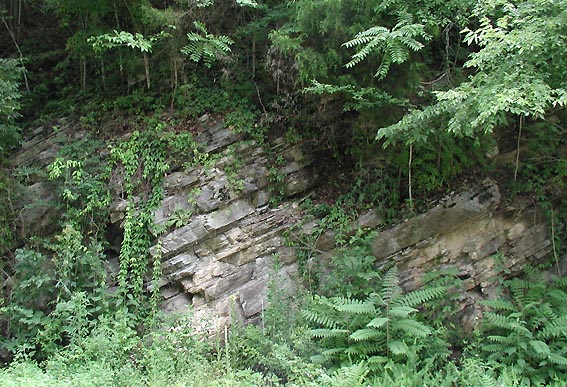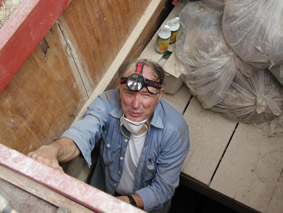
 |
|
|
|
|
|
The Connection between Impact Craters and Shales |
|
| Two studies of fine
grained crater fill sediments are currently in progress:
1) A study of the Flynn Creek Crater
in Tennessee, and |
|
|
Flynn Creek Study |
|
|
|
The Flynn Creek Study was conducted in
collaboration with Dave Roddy (Scientist Emeritus, USGS, Flagstaff),
and Jeff Over (conodont ages) is largely completed. Initial results
have been presented at the 2000 GSA meeting in Reno/Nevada, and a
book chapter has been published: Schieber, J., and Over, J., 2005, Sedimentary Fill of the Late Devonian Flynn Creek Crater: A Hard Target Marine Impact. In: Over, D.J., Morrow, J.R., and Wignall, P.B., eds., Understanding Late Devonian and Permian-Triassic Biotic and Climatic Events: Towards an Integrated Approach, Elsevier, p. 51-69. Link |
|
|
|
| The Flynn Creek crater in north-central Tennessee was produced when a cometary body struck a flat lying succession of Ordovician carbonates. Conodont data from Devonian (Upper Givetian to Lower Frasnian) lag deposits that overly the Ordovician succession in the region, indicate flooding by the Devonian sea during the upper Givetian. A lack of shale accumulation suggests that these initial Devonian sediments were deposited in frequently winnowed shallow water. In the context of storm deposits found in the overlying Chattanooga Shale, the water depth during lag accumulation was probably on the order of 10 meters or less. | |
 Originally flat lying Ordovician carbonates were deformed and tilted in the central portion of the crater. |
|
|
|
|
| Within the crater, fractured and deformed bedrock is overlain by very coarse and chaotic breccia. The top portion of the breccia systematically fines upwards. Depending on location, one or more additional units of fine breccia and/or sand to silt size carbonate debris with weakly developed bedding are encountered above the graded breccia unit. Layers of bedded breccia are separated from the latter, as well as from each other, by thin, soft partings that consist of a mixture of clays, quartz sand and silt, carbonate debris, phosphatic debris, and conodonts. The conodonts are lower Frasnian in age and overlap with those found in lag deposits outside of the crater. These beds are in turn overlain by Devonian black shales. | |
| Detailed study of crater stratigraphy and sedimentary features suggest the following sequence of events: (1) impact in shallow water during the lower Frasnian (381-382m.y.); (2) formation of the basal chaotic breccia as a fall-back deposit; (3) deposition of graded breccia as displaced water rushed back into the crater; (4) while the sea was still shallow, ejected material was washed back into the crater by storm-induced waves and currents; (5) with rising sea level, black shales were able to accumulate, first in the crater, and later also outside the crater. | |
|
|
|
| Above picture shows an outcrop of Devonian shales (Chattanooga Shale) in the crater vicinity. The two regional subdivisions of the Chattanooga Shale, the Dowelltown and Gassaway member, are clearly visible. Whereas outside of the crater Devonian black shales only measure approximately 7-8 meters in thickness, within the crater there is a total thickness of up to 55 meters of Devonian black shales. Most of this thickness represents an early Frasnian black shale succession that was deposited prior to deposition of the Chattanooga Shale as shown above, and attests to a pre-Chattanooga episode of Devonian black shale accumulation. Yet, because of widespread erosion prior to Chattanooga deposition, this black shale unit has only been preserved in localized depressions, such as the Flynn Creek crater. | |
| Meteor
Crater near Winslow Arizona is the world's best preserved Meteor
crater (Barringer Meteor Crater), and the first one that was
correctly interpreted as the result of a Meteor impact. The
geologic relationships and processes recognized at Meteor Crater
have been highly influential for the study of impact sites all over
the world.
As at Flynn Creek, the Barringer Meteor Crater contains a post-impact sediment fill that so far has gone largely unstudied. A study of the crater fill was underway in collaboration with Dave Roddy (Scientist Emeritus, USGS, Flagstaff). The crater fill is exposed in old mine shafts that were constructed early in the 20th century while Daniel Moreau Barringer searched for the fortune in meteoritic iron which he was convinced lay at the bottom of the crater. Initial examination of crater sediments was carried out in August 2000, and a comprehensive study of the crater succession was planned for 2001 (due to Dr. Roddy's health and his untimely death in March 21st 2002, this project is currently on hold). With erosion prevalent elsewhere in the region for most of the Quaternary, the Meteor Crater fill is important because the crater depression allowed preservation of a 50,000 year sedimentary record that may reveal new insights into the quaternary climatic history of the region, as well as into post-impact depositional processes. |
|
 |
 |
| The shaft opening at bottom of the floor of Meteor Crater, the "Gates to Hell" are open. | Dave Roddy returning from the depth of the shaft. It's dusty down there. |
|
|
|
| Back to SHALE RESEARCH LAB Main Page | |
| Back to IU Department of Geological Sciences | |
|
© Jürgen Schieber, IU Bloomington Department of
Geosciences Last updated: November 04, 2023. |
|